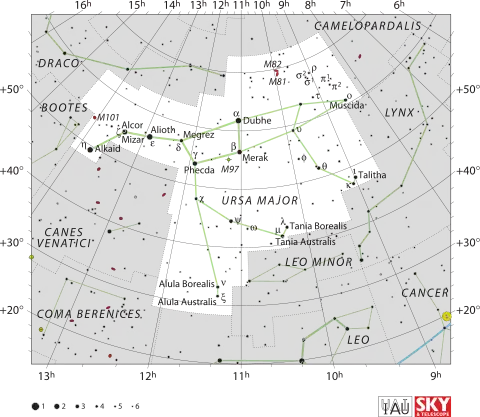Rho Ursae Majoris
Rho Ursae Majoris (ρ UMa) is the Bayer designation for a solitary[9] star in the northern circumpolar constellation of Ursa Major. It is faintly visible to the naked eye with an apparent visual magnitude of 4.74.[2] The distance to this star, based upon an annual parallax shift of 10.37 mas,[1] is around 315 light years.

| |
| Observation data Epoch J2000.0 Equinox J2000.0 (ICRS) | |
|---|---|
| Constellation | Ursa Major |
| Right ascension | 09h 02m 32.69092s[1] |
| Declination | +67° 37′ 46.6280″[1] |
| Apparent magnitude (V) | 4.74[2] |
| Characteristics | |
| Spectral type | M3 III[3] |
| U−B color index | +1.84[2] |
| B−V color index | +1.56[2] |
| Astrometry | |
| Radial velocity (Rv) | 4.75±0.19[4] km/s |
| Proper motion (μ) | RA: −22.83[1] mas/yr Dec.: +18.13[1] mas/yr |
| Parallax (π) | 10.37 ± 0.25[1] mas |
| Distance | 315 ± 8 ly (96 ± 2 pc) |
| Absolute magnitude (MV) | +0.06[5] |
| Details | |
| Radius | 58[6] R☉ |
| Luminosity | 464[7] L☉ |
| Temperature | 3,725[7] K |
| Other designations | |
| Database references | |
| SIMBAD | data |
With a stellar classification of M3 III,[3] this is a red giant star on the asymptotic giant branch.[10] It is a suspected small amplitude variable.[11] The measured angular diameter of the star after correcting for limb darkening is 5.64±0.15 mas,[12] which, at the estimated distance of this star, yields a physical size of about 58 times the radius of the Sun.[6] It is radiating 464 times the solar luminosity from its outer atmosphere at an effective temperature of about 3,725 K.[7] Based upon its motion through space, there is a 60.6% chance that this star is a member of the Sirius stream.[5]
Naming
- With π1, π2, σ1, σ2, A and d, it composed the Arabic asterism Al Ṭhibā᾽, the Gazelle.[13] According to the catalogue of stars in the Technical Memorandum 33-507 - A Reduced Star Catalog Containing 537 Named Stars, Al Ṭhibā were the title for seven stars : A as Althiba I, π1 as Althiba II, π2 as Althiba III, this star (ρ) as Althiba IV, σ1 as Althiba V, σ2 as Althiba VI, and d as Althiba VII[14]
- In Chinese, 三師 (Sān Shī), meaning Three Top Instructors, refers to an asterism consisting of ρ Ursae Majoris and σ2 Ursae Majoris. Consequently, the Chinese name for ρ Ursae Majoris itself is 三師一 (Sān Shī yī, English: the First Star of Three Top Instructors.).[15]
References
- van Leeuwen, F. (2007), "Validation of the new Hipparcos reduction", Astronomy and Astrophysics, 474 (2): 653–664, arXiv:0708.1752, Bibcode:2007A&A...474..653V, doi:10.1051/0004-6361:20078357, S2CID 18759600.
- Mermilliod, J.-C. (1986), "Compilation of Eggen's UBV data, transformed to UBV (unpublished)", Catalogue of Eggen's UBV Data, SIMBAD, Bibcode:1986EgUBV........0M.
- Marrese, P. M.; et al. (August 2003), "High resolution spectroscopy over lambda lambda 8500-8750 Å for GAIA. IV. Extending the cool MK stars sample", Astronomy and Astrophysics, 406: 995–999, Bibcode:2003A&A...406..995M, doi:10.1051/0004-6361:20030647.
- de Bruijne, J. H. J.; Eilers, A.-C. (October 2012), "Radial velocities for the HIPPARCOS-Gaia Hundred-Thousand-Proper-Motion project", Astronomy & Astrophysics, 546: 14, arXiv:1208.3048, Bibcode:2012A&A...546A..61D, doi:10.1051/0004-6361/201219219, S2CID 59451347, A61.
- Famaey, B.; et al. (January 2005), "Local kinematics of K and M giants from CORAVEL/Hipparcos/Tycho-2 data. Revisiting the concept of superclusters", Astronomy and Astrophysics, 430 (1): 165–186, arXiv:astro-ph/0409579, Bibcode:2005A&A...430..165F, doi:10.1051/0004-6361:20041272, S2CID 17804304.
- Lang, Kenneth R. (2006), Astrophysical formulae, Astronomy and astrophysics library, 1 (3rd ed.), Birkhäuser, ISBN 3-540-29692-1. The radius (R*) is given by:
- McDonald, I.; et al. (2012), "Fundamental Parameters and Infrared Excesses of Hipparcos Stars", Monthly Notices of the Royal Astronomical Society, 427 (1): 343–57, arXiv:1208.2037, Bibcode:2012MNRAS.427..343M, doi:10.1111/j.1365-2966.2012.21873.x, S2CID 118665352.
- "rho UMa". SIMBAD. Centre de données astronomiques de Strasbourg. Retrieved 2017-02-25.
- Eggleton, P. P.; Tokovinin, A. A. (September 2008), "A catalogue of multiplicity among bright stellar systems", Monthly Notices of the Royal Astronomical Society, 389 (2): 869–879, arXiv:0806.2878, Bibcode:2008MNRAS.389..869E, doi:10.1111/j.1365-2966.2008.13596.x, S2CID 14878976.
- Eggen, O. J. (1992), "Asymptotic giant branch stars near the sun", The Astronomical Journal, 104: 275, Bibcode:1992AJ....104..275E, doi:10.1086/116239.
- Percy, J. R.; et al. (1994), "Photometric surveys of suspected small-amplitude red variables. III: An AAVSO photometric photometry survey", Astronomical Society of the Pacific, 106 (700): 611–615, Bibcode:1994PASP..106..611P, doi:10.1086/133420.
- Richichi, A.; et al. (February 2005), "CHARM2: An updated Catalog of High Angular Resolution Measurements", Astronomy and Astrophysics, 431 (2): 773–777, Bibcode:2005A&A...431..773R, doi:10.1051/0004-6361:20042039.
- Allen, Richard Hinckley (1899), Star-Names and Their Meanings, New York: G. E. Stechert, p. 444
- Rhoads, Jack W. (November 15, 1971), Technical Memorandum 33-507-A Reduced Star Catalog Containing 537 Named Stars (PDF), Jet Propulsion Laboratory, California Institute of Technology.
- (in Chinese) AEEA (Activities of Exhibition and Education in Astronomy) 天文教育資訊網 2006 年 6 月 16 日